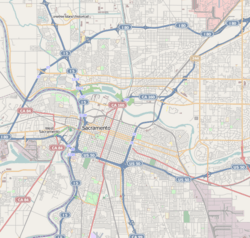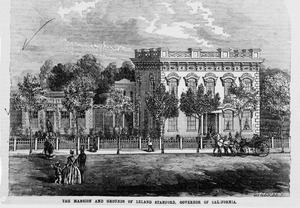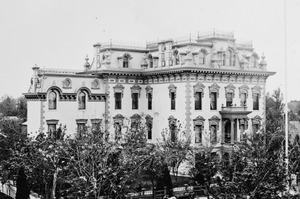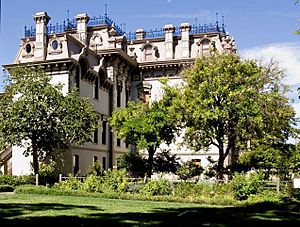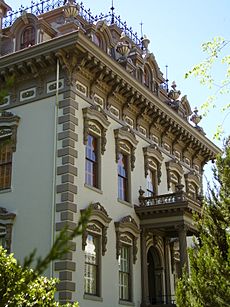Leland Stanford Mansion facts for kids
|
Leland Stanford Mansion
|
|
 |
|
| Location | Sacramento, California |
|---|---|
| Built | 1856 |
| Architect | Seth Babson |
| Architectural style | Second Empire |
| NRHP reference No. | 71000178 |
Quick facts for kids Significant dates |
|
| Added to NRHP | December 9, 1971 |
| Designated NHL | May 28, 1987 |
The Leland Stanford Mansion, often known simply as the Stanford Mansion, is a historic mansion and California State Park in Sacramento, California, which serves as the official reception center for the Californian government and as one of the official workplaces of the Governor of California.
Built in 1856, the mansion was formerly the residence of Leland Stanford, 8th Governor of California and founder of Stanford University. The Stanford family donated the estate to the Roman Catholic Diocese of Sacramento in 1900, which maintained a children's home on the estate until 1978. Subsequently, the Californian government purchased the property to serve as the Californian capital's ceremonial reception center and as a state park, officially known as the Leland Stanford Mansion State Historic Park.
History
The original owner and builder of the home was Sacramento merchant Shelton C. Fogus, a wealthy Sacramento building merchant. The Renaissance Revival architecture of the original home is attributed to Seth Babson, who later designed the E.B. Crocker residence and art gallery that are now part of the Crocker Art Museum.
Stanford family
Leland Stanford, president of the Central Pacific Railroad (one of the Big Four tycoons) and a rising member of the Republican Party, purchased the home for $8,000 (equivalent to $261,000 in 2022) in June 1861, shortly before his election as California governor that year. During his two-year governorship, the Stanford Mansion served as the state's executive office and living quarters. Succeeding governors Frederick Low and Henry Huntly Haight would also make the mansion their office.
Between 1871 and 1872, the Stanford family embarked on an ambitious remodeling of the residence. As Stanford had had to attend his gubernatorial inauguration by rowboat in 1862, the home was raised twelve feet in response to frequent flooding from the Sacramento River. In addition, one story was added to both the bottom and top of the mansion. The home was also expanded from 4,000 square feet (370 m2) to 19,000 square feet (1,800 m2), and redesigned to reflect the French Second Empire architecture popular of the period, particularly in the 4th floor Mansard roof that caps the home. The result was a four-story remodeled architectural sandwich in which the original 2-story house sat between the added floors.
Following Stanford's death in 1893, his widow Jane Lathrop Stanford continued to oversee the home.
Diocese of Sacramento ownership
In 1900, Jane Stanford donated the home to the Roman Catholic Diocese of Sacramento to be used for the children of California. It was given to the Sisters of Mercy who ran it as an orphanage named the Stanford and Lathrop Memorial Home for Friendless Children.
In 1932, the home was handed over the Sisters of Social Service who eventually transformed the mansion from an orphanage to a residence for dependent high school girls. A fire in the mansion in 1940 brought considerable damage to the fourth floor.
The mansion was designated a California Historical Landmark in 1957 and a National Historic Landmark in 1987.
Restoration
Beginning in 1991, with the help of Sacramento businessman and former Stanford University professor Peter McCuen, the Stanford Mansion underwent a 14-year renovation at a cost of $22 million ($47.27 million in 2022). Accurate restoration of the home and its rooms was aided by both an extensive study of the home in 1986 through the Historic American Buildings Survey, and through a large collection of photographs of the home taken in 1868 by Alfred A. Hart, and again in 1872 by Eadweard Muybridge.
The repairs and restoration were completed in 2005, when the mansion opened to the public. California State Parks offers guided tours through the fully refurbished home. Rooms of the house have been restored to their 1872 appearance. The Leland Stanford Mansion is physically accessible, including the gardens, Visitor Center and restrooms. Elevators provide access to the upper floors of the mansion's tour route. A tactile model of the Mansion is also available in the Visitor Center.
See also
 In Spanish: Mansión Leland Stanford para niños
In Spanish: Mansión Leland Stanford para niños


